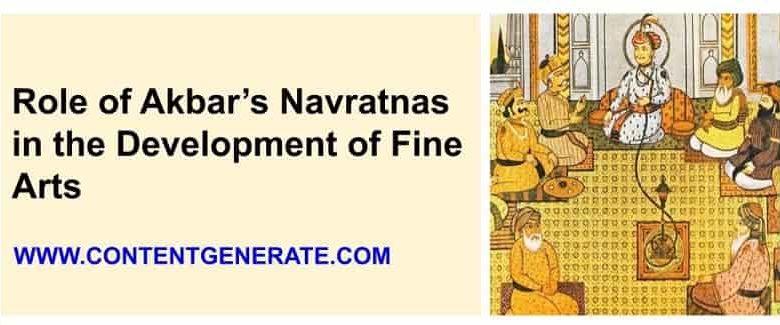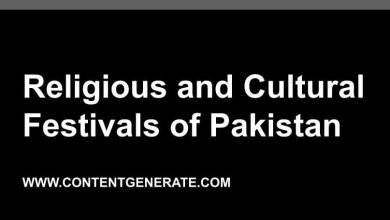Akbar’s Navratnas and Development in Fine Arts

During the reign of the third Mughal emperor Jalaluddin Akbar all three major branches of Fine Arts (architecture, painting, and calligraphy) received immense royal patronage and tremendous momentum. In this article, we will evaluate the role of Akbar’s navratnas in the field of fine arts.
Contents
Akbar’s navratnas, a brief introduction
Navaratnas or Nauratan (nine gems) were nine outstanding people in a Mughal court that acted as advisors to the Emporer. It was not only the Mughals who have navratnas. Legendary Indian emporers as such as Vikramaditya and the feudal lord Raja Krishnachandra also used to have them for advice on matters of importance.
Akbar’s navratnas represented diverse religions and languages. They were the most genius and extraordinary people, called the nine gems, selected by the emperor to help administer the empire. They included Raja Birbal, Miyan Tansen, Abul Fazal, Faizi, Raja Man Singh, Raja Todar Mal, Mullah Do Piazza, Fakir Aziao-Din, Abdul Rahim Khan-I-Khana.
Akbar’s Nau-Ratans were not only political advisors, they were the writers, poets, musicians, architects, calligraphers of a high standard. With their genius and exceptional talent and commitment, they set a legacy in all types of art and literature that became a hallmark of the Mughal period.
Role of Akbar’s navratnas in the field of fine arts
The main forms of fine art that flourished under the greatest of the Mughal king Akbar were as follows:
1. Miniature Painting
Miniature painting flourished and reached its apex during the period of the third Mughal emperor Akbar. The emperor himself was well versed from an early age. He got training as an artist under Sayid Ali, a Persian artist of prominence who came to India at the invitation of the second Mughal emperor, Humayun.
Akbar established an atelier at Fatehpur Sikri under the leadership of Sayyid Ali and Khwaja Abdul Samad under whom hundreds of artists across the Indian subcontinent worked to produce extraordinary artistic artifacts. The two legendary miniaturists gave birth to the Indo-Persian style of art, an amalgam of both Persian and Indian art.
Akbar was so much fond of the art of miniature paintings that he daily visited the atelier. He would examine the work produced by the artists and reward the outstanding painters on daily basis.
Uses of the miniature paintings
The miniature paintings produced during the reign of Akbar found their way into book illustrations, portraits of individual kings, and nature.
i. Use in book illustrations
Under the royal patronage, book illustrations related to a variety of subjects, e.g. love, poetry, myths, fables, legends, etc. were produced. Artists were grouped into specialized painters, colorists, portrait makers. Each group was led by a group leader who used to be an artist of top quality who formulated the composition and provided a rough outline. The further work was executed by the group members under the supervision of the group leader.
Tutti Nama and Dastan-e-Amir Hamzeh, produced during 1560 to 1570, with 14000 illustrations, were the two earliest illustrations of Akbar’s period. Contrary to the later works, the illustrations of Akbar’s period were relatively large in size. Unfortunately, only 200 illustrations have survived out of a total of 1400 illustrations.
ii. Portrait making
A large number of portraits of the emperor Akbar were made in the atelier of Akbar’s court at Fatehpur Sikri. The artists also produced a large number of portraits of studies of natural life and genre scene.
2. Architecture
Historiographers credit Akbar with laying down the foundation of Mughal architecture. According to them, it was Akbar who encouraged the development of an Indo-Persian architectural style. He commissioned royal palaces, mausoleums, gardens, mosques, etc during his rule from1556–1605.
Constructions made of Redstone and marble at Fatehpur Sikri, Akbar’s headquarters from 1571 to 1585 represent a syncretic model of remarkable architecture. Timurid forms and styles dominate the structures with deep influences of Gujarati style and Hindu form of domestic architecture.
Buildings other than those erected at Fatehpur Sikri include the fort at Agra (1565–74) the ʿArab Saraʾi in Delhi (1560–61), the Ajmer fort (1564–73), the Lahore Fort (1586–1618), the Allahabad Fort (1583–84), and the most important Humanyun’s tomb completed in 1570.
The architectural monuments erected during Akber’s reign inspired the future Indian architecture. In this regard, Humayun’s tomb holds great importance as its architectural style inspired the future architectural wonder, the Taj Mahal.
3. Calligraphy
One cannot ignore the role of Akbar’s Navratnas when it comes to the development of the art of calligraphy. The history of Mughal calligraphy started with Babur, the founder of the Mughal empire but Humayun actually laid the foundation on which his son Akbar built the superstructure. (Rahman 1987).
Akbar utilized the facilities created by Humayun and raised the art of calligraphy to un-precedent heights. The royal patronage of fine arts attracted people of extraordinary talent across India who worked with the Persian calligraphers at the royal atelier at Fatehpur Sikri to produce artifacts of high excellence.
A variety of styles and elegant patterns were invented by master calligraphers using the Arabic script. They demonstrated their skills, in writing Quranic verses, on the facades and walls of architectural monuments i.e. mosques, palaces, mausoleums. Moreover, the calligraphers skilfully employed Naskh, Thulth, Tughra, and Nastaliq styles for epigraphic and decorative purposes. The work bears testimony to the highest aesthetic quality the calligraphers maintained throughout.
To give few examples, the architectural structures at Fatehpur Sikri display a stunning calligraphic work made under Akbar. The inscriptions in gold on the wall surface of the Mausoleum of Salim Chisti in Tughra style display calligraphic work of high excellence. Similarly, the illustrations as part of the Great Mosque at Fatehpur Sikri display another superb work in Naskh and Tulth and Nastaliq styles of calligraphy.
References
1. RAHMAN, P. M. (1987). Mughal Calligraphy. Islamic Studies, 26(3), 237-246.




